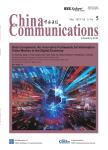Radio Propagation and Wireless Coverage of LSAA-Based 5G Millimeter-Wave Mobile Communication Systems
Radio Propagation and Wireless Coverage of LSAA-Based 5G Millimeter-Wave Mobile Communication Systems作者机构:School of Information Science and EngineeringSoutheast UniversityNanjing 211111China State Key Laboratory of Millimeter WavesSoutheast UniversityNanjing 211111China National Mobile Communications Research LaboratorySoutheast UniversityNanjing 211111China
出 版 物:《China Communications》 (中国通信(英文版))
年 卷 期:2019年第16卷第5期
页 面:1-18页
核心收录:
学科分类:0810[工学-信息与通信工程] 0808[工学-电气工程] 0809[工学-电子科学与技术(可授工学、理学学位)] 08[工学] 0839[工学-网络空间安全] 0812[工学-计算机科学与技术(可授工学、理学学位)]
基 金:supported in part by the National Natural Science Foundation of China under Grant No.61671145 the Key R&D Program of Jiangsu Province of China under Grant BE2018121
主 题:fifth generation (5G) channel modeling large-scale antenna array(LSAA) millimeter wave(mmWave) communications radio propagation measurements wireless coverage
摘 要:Millimeter-wave(mm Wave) communications will be used in fifth-generation(5G) mobile communication systems, but they experience severe path loss and have high sensitivity to physical objects, leading to smaller cell radii and complicated network architectures. A coverage extension scheme using large-scale antenna arrays(LSAAs) has been suggested and theoretically proven to be cost-efficient in combination with ultradense small cell networks. To analyze and optimize the LSAA-based network deployments, a comprehensive survey of recent advances in statistical mmWave channel modeling is first presented in terms of channel parameter estimation, large-scale path loss models, and small-scale cluster models. Next, the measurement and modeling results at two 5G candidate mmWave bands(e.g., 28 GHz and 39 GHz) are reviewed and compared in several outdoor scenarios of interest, where the propagation characteristics make crucial contributions to wireless network designs. Finally, the coverage behaviors of systems employing a large number of antenna arrays are discussed, as well as some implications on future mmWave cellular network designs.



